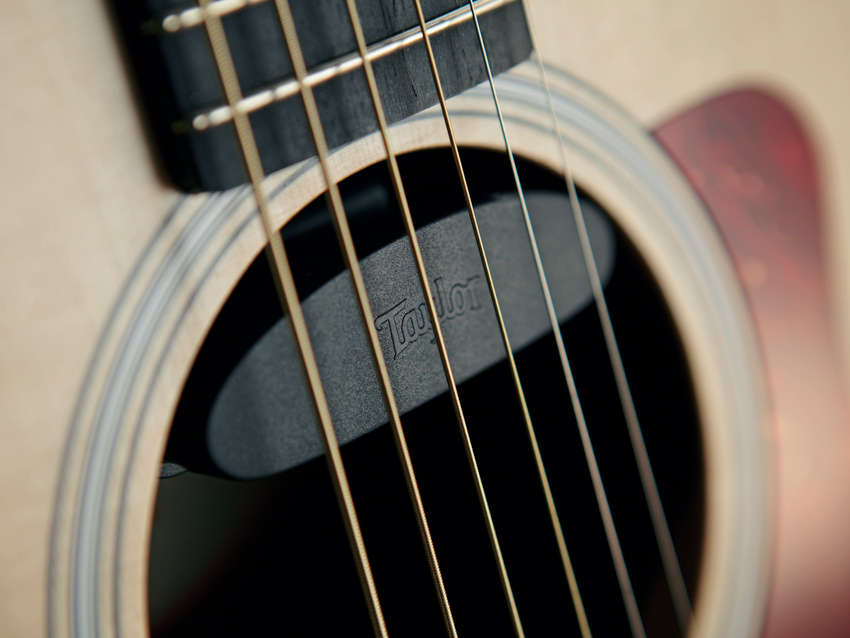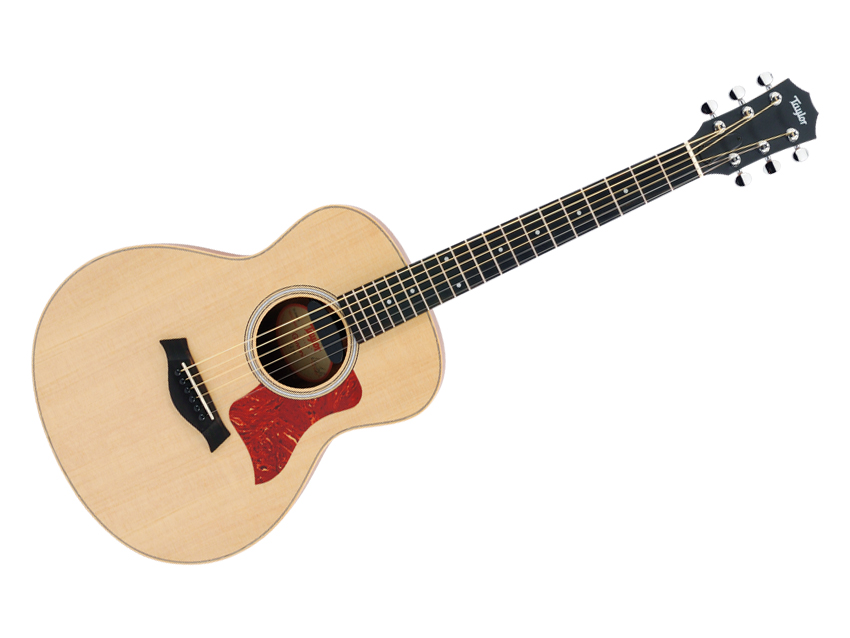MusicRadar Verdict
More than just a travel guitar, the GS Mini has its own acoustic voice that can easily be amplified with the good-sounding ES-Go pickup. Impossible not to like.
Pros
- +
Concept. Build quality and design. Sound and playability. Price. Accessories range.
Cons
- -
Nothing, really, though cedar-topped and nylon-stringed versions would be nice.
MusicRadar's got your back

GS Mini

GS Mini

GS Mini
Aptly titled, the GS Mini is exactly that: a down-sized Taylor GS-shaped acoustic guitar. Built in its Mexican factory (along with the Baby, 100 and 200 series) it was launched in the USA last autumn and is now available in the UK.
Taylor obviously sees it as a travel guitar, but perhaps their description of a "modern day parlour guitar" is just as accurate. But we're getting ahead of ourselves…
- Explore more of the best guitars for beginners
Build
So, just how mini is the Mini? Well, compared to the full-size Taylor GS (grand symphony), introduced in 2006, the Mini cuts 51mm off the scale length and just 86mm off the overall length. Width-wise we lose approximately 48mm, but only 5mm from the depth.
It's more compact than the full scale length Big Baby, although slightly bigger in depth, and the Mini's 597mm (23.5-inch) scale is longer than the 578mm (22.75-inch) of the Baby.
The laminate back and sides and solid Sitka top are all unbound so expect some dings and wear to the body edges over time. Decoration is minimal: black/white/black top edge purfling and inlaid black and white soundhole rings.
Internally too, although it's typically very clean, the top's X-bracing and other struts are left quite square edged; there's no back bracing thanks to the pressed bulbous curve of the laminate.
"The unbound ebony 'board is beautifully precise, with just simple pearlod dot markers on the face."
The finish is a thin satin, which does a lot to enhance the resonant feel, but not a lot to protect the guitar from road wear. A single-ply faux tortoiseshell pickguard will at least protect the top from the major pick and nail wear, but if you like your guitar all gloss, shiny and pristine then the Mini probably isn't for you.
Want all the hottest music and gear news, reviews, deals, features and more, direct to your inbox? Sign up here.
The sharpness of build extends to the neck, which uses Taylor's NT system to affix it to the body. The unbound ebony 'board is beautifully precise and clean too, with just simple 5mm pearloid dot markers on the face and smaller dots on the sides.
Taylor's standard wire is employed - a little under 2mm wide and just proud of 1mm high - and is typically cleanly installed and fettled with smooth, rounded crowns.
Profile-wise the neck has a slight soft 'V' and, with Taylor's narrowest nut width, it all feels really quite 'electric' despite the full 56mm string spacing at the Taylor-style ebony bridge.
Set-up is immaculate: the NuBone nut - a more affordable derivative of Graph Tech's proprietary Tusq material - is very well cut and the compensated NuBone saddle ensures plenty good enough intonation while the 1.2mm treble/2mm bass string height at the 12th continues its quite electric-like playability.
That said, and despite the shorter scale, the supplied Elixir medium-gauge Nanowebs ensure a firm feel and plenty of power to drive that top; the slightly shorter scale length is easy to adjust too, although we'd suspect a wider nut width option would make fingerstyle players more comfortable.
Tuners are unlogo'd enclosed types - perfectly good - and we get just black plastic bridge pins but at least, as usual on a Taylor, there's a second strap button on the heel.
Some players find the whole Taylor experience too perfect, too bland, but the quality and consistency is unquestionable.
Our guitar was shipped directly from Taylor HQ in San Diego to snow-laden London; it was incorrectly delivered and hung around for a good two weeks in sub-zero temperatures.
It was shipped in just its included 'hard' (as in firm and very well padded) gigbag, supported at its top and base inside a standard cardboard box. When we eventually got the instrument and unpacked it, it was perfectly in tune: amazing.
If the GS Mini was purely an acoustic, we'd still be rating it highly, but Taylor has designed a specific ES-Go magnetic soundhole pickup for the guitar, which takes just minutes to install.
It pushes into a pre- fitted housing inside the guitar under the fingerboard end; you unscrew the base strap button and replace it with the standard jack-loaded endpin, which is pre-wired to a mini jack that plugs into the pickup's housing - there's even a pre-installed clasp to hold the small length of lead and stop it rattling within the body.
Sounds
Rather like a good parlour-size guitar, the GS Mini outputs a sound that belies its compactness. For sure, it's light in the bass department compared to a big and belting Martin dreadnought but it doesn't sound lacking, in that its voice is both appealing and very musical.
We'd lay a considerable sum to suggest it'd be a fine recording guitar, that tight low end giving space to a bass guitar (or bassier six-string) while the mids aren't overly honky, as some parlours can be, and the silky, sparkly highs are pure Taylor fidelity.
There's tonal depth, strength and resonance aplenty. It doesn't sound like something is missing: it has it's own voice and again we'd wager it would track on top of bigger sounding acoustics very nicely either live or recorded.
The pickup might seem basic with no control whatsoever, but many of us are more than used to that with long-running and best-selling units such as Fishman's Rare Earth.
Running direct into our AER test amp, the ES-Go, although passive, is certainly in a similar ballpark. The pickup senses a very broad frequency response so adding sparkling highs, some low bass and a middle cut easily produces a more than acceptable modern acoustic tone.
Lower fret positions sound more acoustically accurate; as you move up the neck, like the Rare Earth, things become a little more electric-sounding but, we've found over a few hundred gigs with a Rare Earth, that can be to your advantage for bluesier, jazzier lines or bottleneck styles.
Of course, narrow the EQ on your amp or PA and the Mini takes on an older, jazzier and bluesier vibe with none of that piezo undersaddle 'quack'.
Beautifully simplistic in design and concept, the GS Mini is much more than just a travel guitar. Yes, it fits that bill perfectly but Taylor's modern day parlour description is more fitting.
This is a guitar with its own vibe and voice - and both are very appealing. Of course, the guitar is compact and built to a price, but Taylor's vast experience in production guitar manufacturing ensures that these 'economies' don't get in the way of the important things: playability and sound.
Add in the purpose-designed ES-Go pickup, plus a range of other accessories, and you have the sort of high-desire product that's very hard to resist.
- More of the best cheap acoustic guitars under $/£500
Now hear the GS Mini in action...
Dave Burrluck is one of the world’s most experienced guitar journalists, who started writing back in the '80s for International Musician and Recording World, co-founded The Guitar Magazine and has been the Gear Reviews Editor of Guitarist magazine for the past two decades. Along the way, Dave has been the sole author of The PRS Guitar Book and The Player's Guide to Guitar Maintenance as well as contributing to numerous other books on the electric guitar. Dave is an active gigging and recording musician and still finds time to make, repair and mod guitars, not least for Guitarist’s The Mod Squad.
